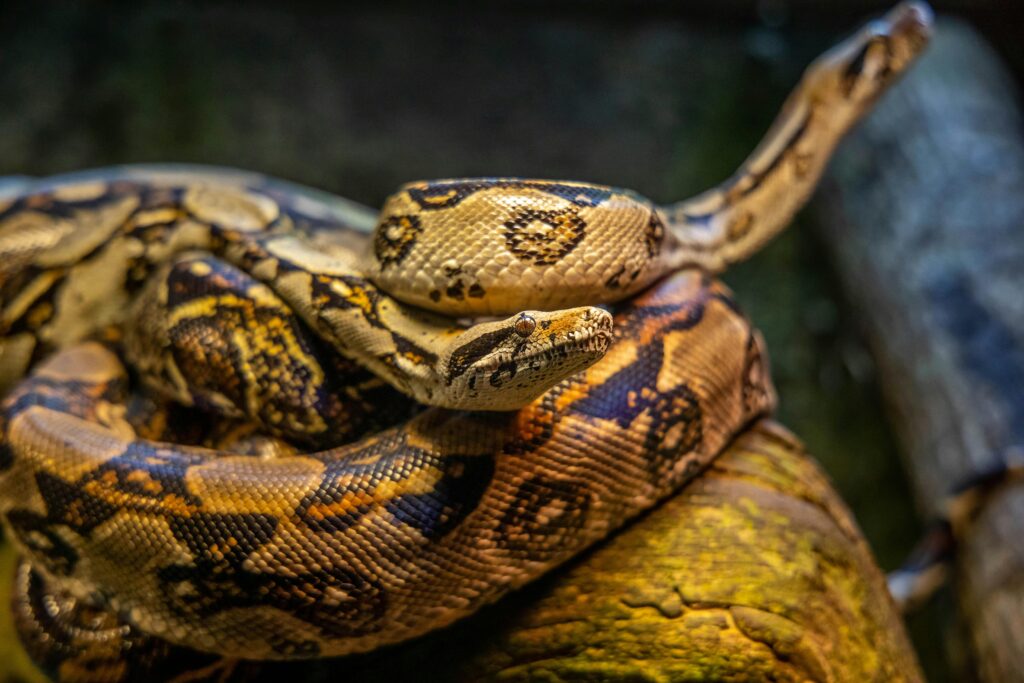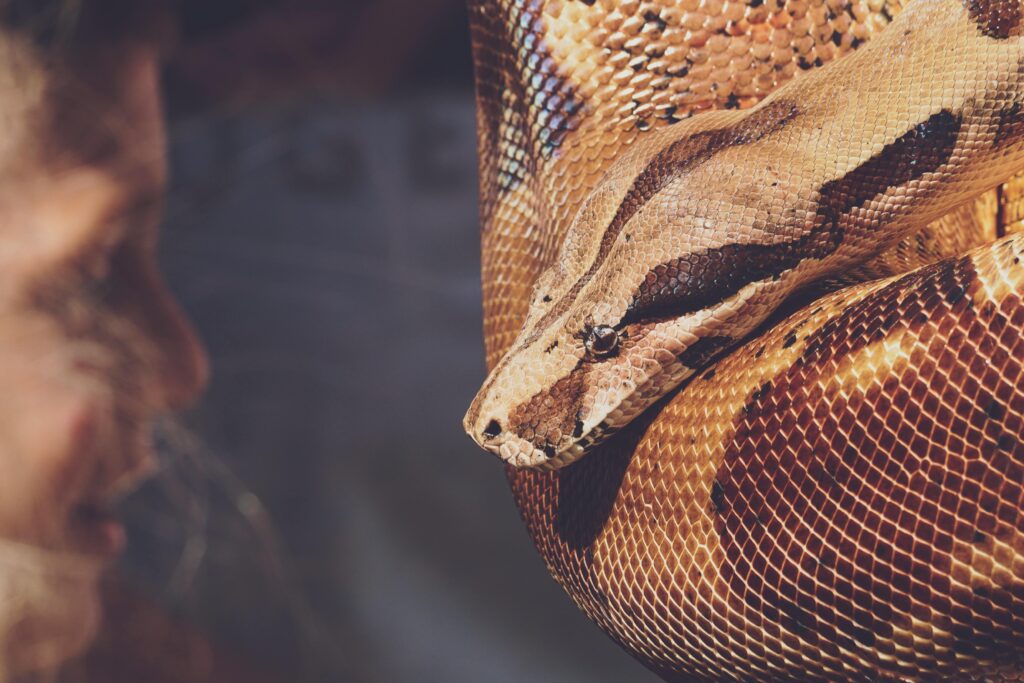Robot Bunnies Are Being Deployed in Florida to Fight Invasive Pythons

The Everglades has always been a place of balance a slow-moving river of grass where panthers stalk deer, wading birds spear fish, and marsh rabbits dart through the reeds. But in recent decades, that balance has been quietly broken by an intruder that doesn’t belong here. The Burmese python, a predator stretching over 15 feet and weighing more than a small child, now rules vast swaths of this ecosystem. Introduced through the exotic pet trade, these snakes have multiplied into the tens of thousands, swallowing nearly everything in their path. Studies by the U.S. Geological Survey show that raccoon populations have plummeted by more than 99%, opossums by nearly the same, and marsh rabbits have all but disappeared.
Fighting them is like trying to spot a single strand of hair in a forest. Detection rates are so low between one and three out of every hundred snakes might be found in a given area that traditional hunting methods can barely make a dent. Yet, in the marshlands of South Florida, a new kind of hunter has emerged. Solar-powered, fur-covered, and no bigger than a football, these mechanical marsh rabbits are part decoy, part spy, and part bait.
They may look like children’s toys, but to a hungry python, they could be the beginning of the end.
How the Burmese Python Took Over
The story of Florida’s python problem begins not in the Everglades, but in living rooms and pet shops. In the 1970s, Burmese pythons native to Southeast Asia were imported to the United States in large numbers as part of the exotic pet trade. The snakes, often sold as manageable hatchlings, could grow to more than 15 feet and weigh over 150 pounds. For many owners, caring for such a massive animal became impossible. Some were deliberately released into the wild; others escaped during storms and hurricanes.
By the mid-1980s, these snakes had established a foothold in Everglades National Park. The combination of abundant prey, a warm climate, and no natural predators created ideal conditions for them to thrive. By 2000, a self-sustaining breeding population was firmly in place, and their range began to expand beyond the park, stretching across more than 1,000 square miles of South Florida. The U.S. Geological Survey estimates that between 1975 and 2018, approximately 180,000 Burmese pythons were imported into the country a pipeline that was only shut down in 2012 with a federal ban on their importation.

The ecological impact has been severe. Research shows catastrophic declines in native mammal populations: raccoons down 99.3%, opossums by 98.9%, bobcats by 87.5%. Marsh rabbits, cottontail rabbits, and foxes have effectively vanished from large parts of the region. Pythons have been found with everything from birds and iguanas to alligators and adult white-tailed deer in their stomachs.
Compounding the crisis is their stealth. Burmese pythons are masters of camouflage, blending into the sawgrass and swamp. Their detection rate in the wild is estimated at just 1% to 3%, meaning most remain hidden even during targeted searches. At Everglades National Park, finding a single snake can take eight hours of dedicated hunting. This combination of high reproductive potential, broad dietary range, and near-invisibility has allowed them to dominate the ecosystem leaving scientists and conservationists searching for unconventional solutions to turn the tide.
Conventional Control Methods and Their Limits

Over the years, Florida has thrown nearly every available tool at the python problem, from grassroots hunts to advanced tracking technology. The Florida Python Challenge a 10-day competition drawing hunters from across the country offers cash prizes for capturing the longest and most pythons. State agencies also run bounty programs, paying professional hunters hourly rates plus bonuses based on the size of the snake. Since 2019, these contracted hunters have removed nearly 16,000 pythons, making this the most productive strategy to date.
Specialized detection teams have also been deployed. In 2020, snake-sniffing detector dogs trained to pick up the reptiles’ scent joined the hunt. Other approaches include attaching radio transmitters to “scout” male pythons, which often lead trackers to egg-laying females, and fitting tracking devices to prey animals like raccoons, opossums, and rabbits so hunters can find the snakes after they feed. In one University of Florida study, nine caged rabbits lured 22 pythons in just three months, proving the concept but also revealing the logistical challenge caring for live bait in remote, swampy terrain is costly and labor-intensive.
Even with these efforts, the reality is sobering. Pythons’ ability to hide in dense vegetation and waterlogged environments means most remain undetected. The average detection rate between one and three snakes per hundred in a survey area makes large-scale removal slow and inefficient. Each method chips away at the population, but none come close to eradicating it. For wildlife managers, the conclusion has been unavoidable: to gain the upper hand, they need tools that can work around the clock, in difficult terrain, without the constraints of human fatigue or live animal care. That search for a more efficient, scalable solution is what led to one of the most unusual weapons in Florida’s python war the robotic rabbit.
Birth of the Robo-Bunny Project

The idea began as a question: if pythons are so hard to find, why not lure them out? Researchers at the University of Florida, led by wildlife ecologist Robert McCleery, had already tested live rabbits as bait in the Everglades. The results proved promising snakes were drawn in consistently but caring for live animals in such an unforgiving environment was slow, costly, and logistically complex. So McCleery teamed up with colleague Chris Dutton, a mechanically inclined ecology professor, to create a decoy that could do the job without the downsides.
They started with an unlikely foundation: toy marsh rabbits from a store shelf. Inside each plush body, they replaced the stuffing with over 30 electronic components solar-powered heaters to mimic body warmth, small motors for subtle, lifelike movements, and waterproof casings to withstand rain and humidity. Motion-activated cameras were installed to watch for snakes, instantly sending alerts when movement matched a python’s pattern. The result was a solar-powered, remote-controlled decoy that could be switched on and off at will, operate for long stretches without maintenance, and survive in the harsh wetland conditions.
Forty of these robo-bunnies were deployed in strategic, undisclosed locations across South Florida in 2025. Secrecy was essential both to prevent tampering and to protect the integrity of the experiment. To increase their appeal, the team even developed a synthetic “rabbit scent” that can be applied if visual cues and heat aren’t enough to entice a snake.
The design offers several key advantages over live bait. There’s no need for daily feeding or veterinary care, no ethical concerns over putting real animals in harm’s way, and no unpredictability the robots move when and how the researchers want. Most importantly, they can sit in prime python habitat 24/7, waiting patiently for a strike.
For Mike Kirkland of the South Florida Water Management District, which funds the project, the potential is significant. If the snakes take the bait, robo-bunnies could help draw them out from some of the most ecologically sensitive and inaccessible areas of the Everglades. In a fight where every captured python matters, these furry machines may prove to be more than just clever gadgets they could be a crucial shift in the balance of this long, difficult war.
Potential Impact on Conservation Efforts

While 40 robotic rabbits will not, on their own, eliminate hundreds of thousands of Burmese pythons, their value lies in what they represent: a scalable, targeted tool that could complement existing removal methods. Unlike human hunters, robo-bunnies can operate day and night without fatigue, quietly stationed in areas where pythons are least likely to be spotted by people. Their built-in cameras and motion sensors turn each unit into both bait and surveillance, gathering data on snake behavior that could inform future control strategies.
If proven effective, the concept could be expanded more units deployed across the Everglades and beyond, possibly adapted to lure other invasive predators. Similar technology could be tailored for conservation challenges in different environments, from feral cats on island ecosystems to invasive rodents in sensitive nesting grounds. The blend of biological knowledge and engineering opens doors for conservationists worldwide to experiment with solutions that are less labor-intensive yet highly targeted.

There are, however, practical considerations. The cost of producing and maintaining a large fleet of robotic decoys must be weighed against their capture success rate. Technological reliability in harsh, wetland environments is another challenge solar panels must function under variable light, and waterproofing must endure prolonged exposure to heat and moisture. Ethical oversight is also important to ensure these devices remain a humane, environmentally responsible tool.
Still, the project signals a shift in mindset: conservation is no longer just about manpower and traditional fieldwork. It’s about innovation using every bit of ingenuity to restore balance to ecosystems under siege. In the case of the Everglades, where each python removed gives native species a fighting chance, the robo-bunny could become not just a quirky experiment, but a vital part of Florida’s long-term defense.
Looking Beyond Florida

Florida’s experiment with robotic rabbits is more than a local wildlife control effort it’s a blueprint for how technology and ecology can intersect to solve global conservation challenges. Around the world, invasive species disrupt fragile ecosystems in ways strikingly similar to the Burmese python’s takeover of the Everglades. From lionfish overrunning Caribbean reefs to cane toads wreaking havoc in Australia, the need for inventive, scalable solutions is urgent.
The principles behind the robo-bunny project mimic natural prey, attract the predator, and pair it with real-time monitoring could be adapted for different species and habitats. Imagine robotic fish designed to lure invasive predators on coral reefs, or scent-emitting land decoys to trap feral cats on vulnerable island bird colonies. These aren’t science-fiction scenarios; they’re practical extensions of a method already being tested in Florida’s wetlands.
Equally important is the lesson in prevention. The Burmese python invasion began with human choices importing exotic pets without fully considering the long-term consequences. Similar stories play out across the globe, reminding us that stopping invasive species at the source is far easier than eradicating them once they’ve spread.
Innovation in the Wild
In the stillness of the Everglades, where the sawgrass sways and the herons stalk the shallows, the fight for balance continues. Every python removed is a small victory a chance for marsh rabbits to return, for bobcats to hunt, for panthers to find enough food to survive. The robo-bunny project may seem unconventional, even whimsical, but behind its fur and motors lies a serious truth: in a world where the threats to nature are often born of human actions, the solutions must be equally human in their creativity and resolve.
Technology alone will not save the Everglades, but it can tip the odds. Coupled with determination, scientific insight, and a willingness to try what’s never been tried before, innovations like the robo-bunny remind us that conservation is not just about protecting the past it’s about shaping the future. If we can imagine a toy rabbit becoming a key player in an ecological battle, perhaps we can imagine and create a world where such battles are no longer necessary.
Loading...

